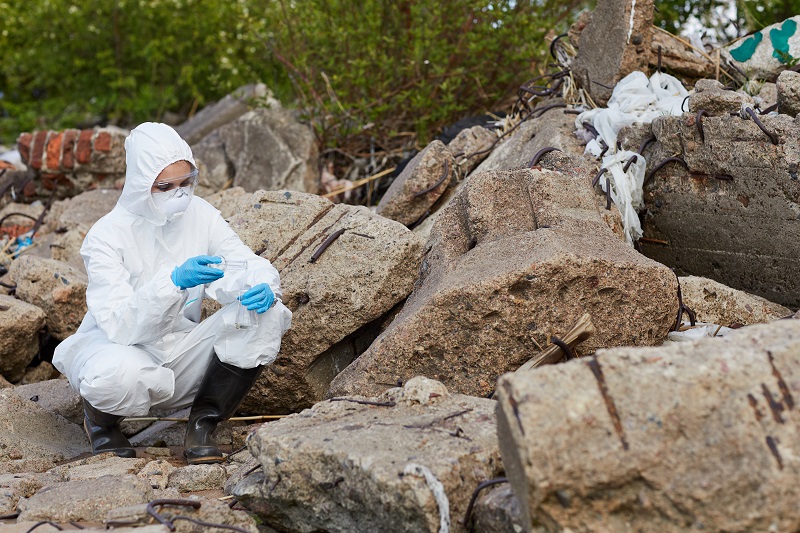Health Implications of Asbestos Exposure
Asbestos exposure poses serious risks to human health. When asbestos-containing materials (ACMs) are disturbed, tiny fibers can become airborne and inhaled. These fibers are incredibly durable and can lodge in the lungs, causing long-term damage. Prolonged exposure has been linked to life-threatening diseases such as asbestosis, lung cancer, and mesothelioma. Protecting individuals from these risks is a primary reason for conducting asbestos risk assessments. Even short-term exposure can be harmful, particularly for vulnerable groups like children or individuals with pre-existing respiratory conditions.
Legal Requirements for Risk Assessments
In many countries, laws mandate regular asbestos risk assessments in workplaces, public buildings, and older structures. For example, employers are often required to comply with regulations that ensure asbestos management and the safety of occupants. Failure to meet these legal obligations can result in heavy fines, legal action, or even criminal charges. Conducting thorough risk assessments not only ensures compliance but also demonstrates a commitment to health and safety.
Environmental Impact of Asbestos
The environmental consequences of improper asbestos management can be severe. When asbestos fibers are released into the air, they can settle on surfaces and contaminate the surrounding environment. This contamination can lead to secondary exposure, where individuals come into contact with fibers indirectly. Proper risk assessments help identify potential sources of fiber release and provide strategies to prevent environmental contamination. By addressing these risks, organizations can minimize their impact on both human health and the environment.
Identifying Asbestos Containing Materials (ACMs)
Common Locations of ACMs
Asbestos-containing materials (ACMs) can be found in various parts of buildings, especially those constructed before the 1990s. Knowing where to look is critical to identifying potential risks. Common locations include:
- Insulation around pipes, boilers, and ducts.
- Ceiling tiles and textured coatings.
- Floor tiles, adhesives, and linoleum.
- Cement sheets, roofing materials, and siding.
- Fireproofing materials and acoustic panels.
Each of these areas should be carefully examined during an assessment, as ACMs may not always be visible at first glance.
Visual Inspection Techniques
A visual inspection is often the first step in identifying ACMs. While this process doesn’t confirm the presence of asbestos, it helps narrow down areas for further testing. Inspectors should:
- Look for materials that appear brittle, damaged, or weathered.
- Note any areas with peeling, cracking, or crumbling surfaces.
- Check for warning labels or documentation indicating the presence of asbestos.
It’s important to remember that visual inspections alone are not enough. Suspected ACMs should be sampled and analyzed by a certified laboratory to confirm their composition.
Using Historical Building Records
Historical building records can provide valuable insights into the potential presence of ACMs. These records may include:
- Original construction blueprints and renovation permits.
- Maintenance logs detailing repairs or material replacements.
- Existing asbestos surveys or risk registers.
Reviewing these documents can save time and help focus efforts on high-risk areas. For example, older records might indicate the use of asbestos insulation in specific sections of a building. Regular inspections and maintenance are also essential to ensure that ACMs are identified and managed effectively.
Assessing the Risks to Health
Evaluating Exposure Levels
When assessing asbestos risks, understanding how much exposure individuals may face is critical. Asbestos fibers become dangerous when airborne, as inhalation can lead to severe health problems. Assessors must determine the levels of asbestos present in the air, which often requires specialized equipment. Sampling methods, such as air monitoring, help measure fiber concentrations and identify areas that pose the greatest threat.
Identifying Vulnerable Groups
Certain groups are more at risk of asbestos exposure than others. Workers in construction, maintenance, or demolition are particularly vulnerable due to their proximity to asbestos-containing materials (ACMs). Additionally, individuals with pre-existing respiratory conditions or weaker immune systems face heightened risks. It’s also essential to consider the general public if the building is in a high-traffic area. Identifying these groups ensures that proper precautions are tailored to their needs.
Understanding Airborne Fiber Risks
The real danger of asbestos lies in its fibers. Once disturbed, these microscopic fibers can linger in the air for hours, making them easy to inhale. Over time, this can lead to diseases like mesothelioma or asbestosis. Assessors must evaluate how likely fibers are to become airborne. Factors include the type of asbestos, its condition, and the activities occurring nearby. For example, even minor vibrations from machinery can dislodge fibers from deteriorating ACMs. Regular monitoring and preventive measures are crucial to minimizing these risks.
Determining the Likelihood of Asbestos Disturbance
Factors Influencing Disturbance
Understanding what might disturb asbestos-containing materials (ACMs) is critical for assessing potential risks. The ease with which asbestos fibers can be released into the air depends on several factors. These include the material’s condition, its location, and the types of activities happening nearby. For example:
- Friable asbestos materials, like insulation, are much easier to disturb than non-friable ones, such as floor tiles.
- ACMs in high-traffic areas are more likely to be accidentally damaged.
- Environmental conditions, like vibrations or drafts, can also increase the chance of disturbance.
Activity Levels in Affected Areas
The level of human activity around ACMs plays a big role in determining disturbance likelihood. Areas with heavy foot traffic or frequent maintenance work are at higher risk. Consider these scenarios:
- An ACM located in a locked storage room has minimal risk of disturbance.
- Conversely, ACMs in public hallways or maintenance areas face higher exposure to accidental damage.
- Construction or renovation work near ACMs can significantly elevate the disturbance risk.
Assessors should carefully evaluate how often and how intensively these areas are used to gauge the risk accurately.
Assessing Material Condition
The physical state of the asbestos material is another key factor. Damaged or deteriorating ACMs are more likely to release fibers into the air. When assessing material condition, look for:
- Cracks, breaks, or visible wear and tear.
- Signs of water damage or mold, which can weaken the material.
- Evidence of previous disturbances or repairs.
Regular inspections are essential to monitor these conditions over time. By combining these observations with activity level assessments, a clearer picture of the disturbance likelihood can be developed.
Establishing Safety Measures for Asbestos Management
Control Measures for High-Risk Areas
When dealing with asbestos-containing materials (ACMs), safety should always be the top priority. While it’s nearly impossible to eliminate all risks, effective control measures can significantly reduce exposure to asbestos fibers. Key strategies include:
- Installing proper ventilation systems to limit airborne fibers in the affected areas without impacting other parts of the building.
- Wetting ACMs during handling to minimize the release of fibers into the air.
- Enclosing or sealing off areas containing asbestos to prevent accidental disturbance.
- Restricting access to high-risk zones to authorized personnel only.
Personal Protective Equipment (PPE) Guidelines
Workers interacting with ACMs must be equipped with appropriate PPE to protect themselves. This includes:
- Respiratory protective equipment (RPE) designed to filter out asbestos fibers.
- Disposable coveralls to prevent fibers from clinging to clothing.
- Gloves and footwear specifically designed for asbestos-related tasks.
Employers must ensure that PPE is properly fitted, regularly maintained, and disposed of safely after use.
Safe Work Practices
Developing and enforcing safe work practices is essential to managing asbestos risks effectively. Some best practices include:
- Conducting regular training sessions for workers to ensure they understand the dangers of asbestos and how to handle it safely.
- Using controlled methods, such as wet removal techniques, to reduce fiber release.
- Establishing clear emergency protocols in case of accidental asbestos disturbance.
- Ensuring all asbestos waste is handled and disposed of by licensed contractors to avoid contamination.
By implementing these measures, organizations can comply with the requirements for asbestos management and prioritize the safety of their workers and building occupants.
Documenting the Asbestos Risk Assessment
Key Elements to Include in Reports
When conducting an asbestos risk assessment, preparing a clear and detailed report is a critical step. This document should serve as a comprehensive record of your findings and recommendations. The report must include specific details to ensure transparency and compliance with safety standards.
Here’s what to include:
- A list of all identified asbestos-containing materials (ACMs), including their location and condition.
- Assessment of who might be affected, such as employees, contractors, or visitors.
- The current control measures in place and their effectiveness.
- Recommendations for additional safety measures or updates to existing protocols.
- A timeline for implementing these measures and identifying who is responsible for each action.
Communicating Findings to Stakeholders
Once the report is complete, it’s essential to share the findings with all relevant stakeholders. This includes employees, building occupants, and contractors who may work in the affected areas. The goal here is to ensure everyone understands the risks and the steps being taken to mitigate them.
Key points to communicate:
- The specific asbestos-related hazards identified.
- The precautions that need to be followed to minimize exposure.
- Emergency procedures in case of accidental asbestos disturbance.
Providing this information not only promotes safety but also demonstrates a commitment to maintaining a healthy work environment.
Maintaining an Asbestos Risk Register
An asbestos risk register is a living document that tracks all identified risks and the actions taken to manage them. This register should be regularly updated to reflect any changes, such as new findings or completed safety measures.
Elements to include in the register:
- Details of all ACMs identified, including their risk level.
- Dates of inspections and updates.
- Records of any incidents or disturbances involving asbestos.
By maintaining this register, organizations can ensure ongoing compliance and provide a clear history of their asbestos management efforts. For more detailed guidance, refer to Chris Wood’s asbestos PRA guide.
Regularly Reviewing and Updating Risk Assessments
Frequency of Reviews
Keeping asbestos risk assessments current is not just good practice—it’s essential. An outdated assessment can leave serious gaps in safety and compliance. Regular reviews should be scheduled, typically on an annual basis, to ensure that all information remains accurate and actionable. However, some situations may call for more frequent updates, such as every six months for higher-risk environments.
Responding to Changes in Building Use
Changes in how a building is used can introduce new risks or alter existing ones. For instance, renovations, increased foot traffic, or even a change in tenants can disturb asbestos-containing materials (ACMs). When such changes occur, the risk assessment should be revisited immediately to reflect the new conditions. This proactive approach minimizes the likelihood of accidental asbestos exposure.
Incorporating New Regulations
Asbestos regulations are subject to updates as new research and safety protocols emerge. Staying informed about these changes is vital to maintaining compliance. Incorporating new legal requirements promptly ensures the risk assessment remains valid and effective. Failing to do so could result in penalties or, worse, increased health risks for occupants.
Calculating the Asbestos Risk Assessment Score
Scoring Criteria for Risk Levels
When calculating an asbestos risk assessment score, it’s essential to evaluate specific factors that contribute to potential hazards. These factors include:
- Occupant Activity (0-3): This measures how frequently and intensely an area is used. For example, a storage room may score lower than a busy office space.
- Likelihood of Disturbance (0-3): This considers how likely it is for asbestos-containing materials (ACMs) to be disturbed, such as through accidental damage or routine activities.
- Maintenance Activity (0-3): This evaluates the types and frequency of maintenance tasks in the area. Frequent or invasive maintenance increases the risk.
- Human Exposure Potential (0-3): This assesses how many individuals could be exposed to asbestos fibers if they are released.
Each of these categories is scored individually, and the scores are then combined to calculate the overall risk level.
Interpreting the Results
Once the scores are added together, the final total will fall within a defined range that indicates the level of risk. For instance:
- 1-8 (Minor): Minimal risk, requiring annual monitoring.
- 9-13 (Low): Low risk, with monitoring recommended every six months.
- 14-17 (Medium): Moderate risk, where sealing and annual checks are necessary.
- 18+ (High): High risk, demanding urgent action or removal of ACMs.
These thresholds help prioritize actions and allocate resources effectively to manage asbestos risks.
Action Plans Based on Scores
The asbestos risk assessment score is not just a number; it serves as a guide for action. Here’s how scores translate into management plans:
- Minor Risk: Maintain a record of the ACM and check it annually for deterioration.
- Low Risk: Increase monitoring frequency and ensure the area remains undisturbed.
- Medium Risk: Implement control measures such as sealing or encapsulating ACMs and review conditions yearly.
- High Risk: Immediate action is required, which may include isolating the area or removing the asbestos entirely.
For those looking to simplify the scoring process, consider using an online tool that automates risk calculations based on the VAEA’s risk model. This tool can streamline evaluations and ensure consistent scoring.
Additionally, when assessing ACM friability, the condition of the material plays a significant role. This factor can influence up to 15% of the overall score, as outlined in the ACM friability scale. Understanding these nuances ensures a thorough and accurate assessment.
Training and Competency Requirements for Assessors
Qualifications for Conducting Assessments
To carry out an asbestos risk assessment, assessors must meet specific qualifications. Proper training ensures they can identify, evaluate, and manage asbestos risks effectively. In many cases, this includes obtaining certifications such as the RSPH Level 3 Award in Asbestos Surveying, which is accredited by UKAS. These certifications validate their ability to comply with industry standards and legal requirements. Assessors must also demonstrate practical experience in asbestos management to ensure thorough and accurate evaluations.
Importance of Asbestos Awareness Training
Asbestos awareness training is a foundational step for anyone involved in handling or assessing asbestos. This training provides critical knowledge about the health risks of asbestos exposure, how to identify asbestos-containing materials (ACMs), and the proper procedures for managing them. Courses aligned with standards like ANSI/ASSP Z490.1-2024 ensure that both physical and online training formats meet robust safety and environmental guidelines. Training also emphasizes the importance of maintaining up-to-date knowledge as regulations and best practices evolve.
Selecting a Competent Assessor
Choosing the right assessor is vital. A competent assessor should have not only the required certifications but also a deep understanding of the Control of Asbestos Regulations. They should be skilled in interpreting asbestos surveys, evaluating the condition of ACMs, and assessing the likelihood of disturbance. Additionally, they must communicate findings clearly to stakeholders and suggest actionable safety measures. Employers often rely on third-party specialists or trained employees to fulfill this role, ensuring compliance and workplace safety.
Legal and Regulatory Framework for Asbestos Risk Assessments
Overview of Control of Asbestos Regulations
The Control of Asbestos Regulations establish the foundation for managing asbestos risks. These regulations outline who is responsible for identifying asbestos-containing materials (ACMs), assessing risks, and implementing control measures. Adherence to these rules is not optional—it is a legal obligation. The regulations also mandate that employers ensure any work with asbestos is carried out by qualified individuals who follow strict safety protocols.
Employer Responsibilities
Employers play a central role in asbestos safety. They must:
- Conduct regular asbestos risk assessments on their properties.
- Maintain an updated asbestos register that identifies all ACMs.
- Provide training to employees who may encounter asbestos in their work environment.
- Ensure that any removal or handling of asbestos is performed by licensed professionals.
Failure to meet these responsibilities can lead to serious legal consequences and endanger public health.
Penalties for Non-Compliance
Non-compliance with asbestos regulations can result in steep penalties. These include:
- Fines: Companies found guilty of negligence may face significant financial penalties, sometimes exceeding tens of thousands of dollars.
- Legal Action: Negligence can lead to lawsuits, especially if employees or the public are exposed to asbestos.
- Reputational Damage: Beyond legal and financial consequences, businesses risk losing credibility and trust.
For a detailed list of laws and regulations related to asbestos, consult this comprehensive listing. Additionally, restoration companies can refer to this guide to ensure compliance with OSHA and EPA standards.
Mitigating Environmental Contamination Risks
Preventing Fiber Release
One of the most effective ways to reduce asbestos contamination is by minimizing the release of fibers into the air. Wetting asbestos-containing materials (ACMs) is a widely used method to keep fibers from becoming airborne during handling or removal. Enclosing or sealing ACMs can also help limit exposure, especially in areas where physical disturbance is likely. For high-risk scenarios, isolating the affected area by creating controlled zones ensures that fibers remain contained.
Cleaning and Decontamination Procedures
Proper cleaning and decontamination are critical when dealing with asbestos. Surfaces and tools exposed to asbestos must be cleaned using specialized equipment, such as HEPA-filtered vacuums, to avoid spreading fibers. All personal protective equipment (PPE) used during asbestos work must be thoroughly decontaminated or safely disposed of after use. Additionally, setting up decontamination units for workers can prevent fibers from being transported out of the work area.
Monitoring Air Quality
Continuous air quality monitoring is essential to ensure that asbestos fibers are not present in the environment. Air sampling can help determine whether existing control measures are effective and if additional actions are needed. Regular monitoring is especially important in areas with ongoing asbestos management activities. By keeping track of airborne fiber levels, organizations can take timely steps to protect workers and the public from unnecessary exposure.




